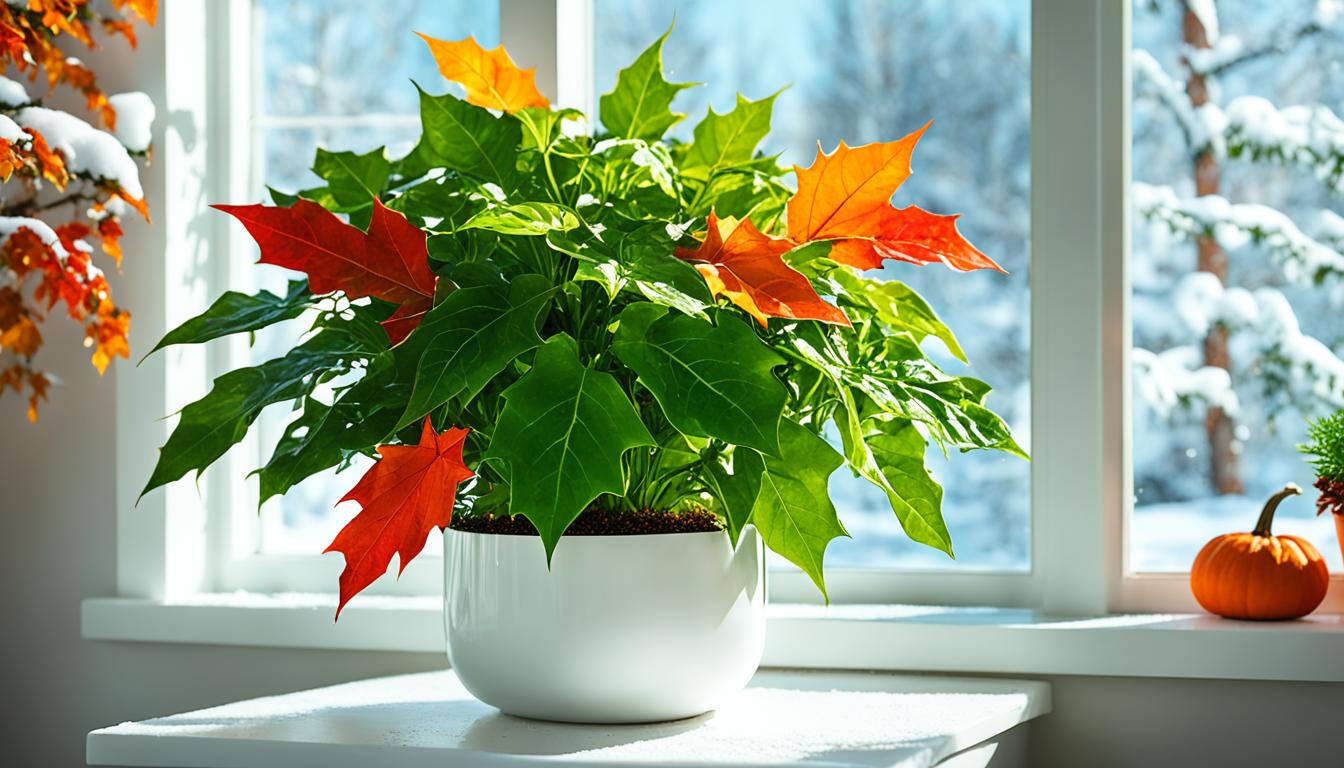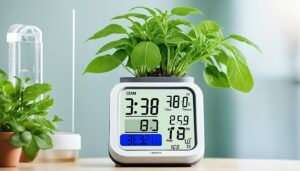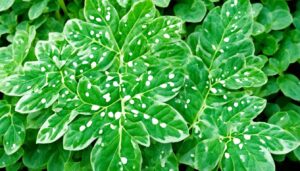Do you think taking care of indoor plants is the same throughout the year? Think again! Indoor plants, just like outdoor plants, go through different seasons, each with its own set of care requirements. Understanding these seasonal changes is crucial to ensure your plants thrive and remain healthy year-round. Are you ready to discover the secrets of successful seasonal indoor plant care?
Indoor plant care needs to be adjusted according to the changing seasons. Understanding how light, water, and temperature variations impact your plants is essential to ensure their growth and health throughout the year.
Key Takeaways:
- Indoor plant care needs to be adjusted according to the changing seasons.
- Understanding light, water, and temperature variations is essential for the health and growth of your plants.
- Different seasons bring changes in light color, intensity, and temperature, which impact indoor plant growth.
- Adjusting watering frequency, fertilization, and light exposure based on the season is crucial for the wellbeing of your indoor plants.
- Monitoring soil moisture, repotting when needed, and maintaining indoor humidity are important aspects of seasonal indoor plant care.
The Influence of Light on Plant Growth
The colors of light play a crucial role in the growth and development of plants. Among the various colors in the light spectrum, blue and red light have the greatest impact on plant growth. In this section, we’ll explore the significant effects of blue light on plants, including phototropism, chlorophyll synthesis, stomatal regulation, and overall plant development.
Blue light is essential for plants as it influences their phototropism, which is the movement of plants in response to light. This phenomenon helps plants position themselves optimally to maximize light absorption. Additionally, blue light stimulates chlorophyll synthesis, which is vital for photosynthesis, the process through which plants convert light into energy.
Furthermore, the presence of blue light affects stomatal regulation, which is the opening and closing of tiny pores on plant leaves. Stomata play a crucial role in gas exchange and water regulation. Blue light helps regulate this process, ensuring efficient gas exchange and proper water balance within the plant.
The influence of blue light extends beyond these physiological processes. It also impacts overall plant development, including stem elongation, leaf expansion, and flowering. Different seasons bring changes in the light color spectrum, and these variations can have a profound effect on the growth, coloration, and flowering of indoor plants.
Did you know? Blue light-emitting diodes (LEDs) are often used in indoor gardening setups to provide the necessary wavelength for promoting plant growth and development.
Understanding the Effects of Blue Light on Plants
Blue light has been found to have various effects on plants:
- Promotes compact and sturdy growth
- Influences leaf coloration, especially in certain plant varieties
- Plays a role in triggering flowering
- Affects the circadian rhythms of plants
These effects highlight the significant role that blue light plays in the overall health and vitality of indoor plants. Understanding the impact of light on plant growth allows you to provide the ideal lighting conditions for your beloved plants.
Now that we’ve explored the influence of light on plant growth, let’s dive into understanding the seasonal shifts in light colors and how they impact indoor plants.
Effects of Blue Light on Plants
| Aspect | Effect of Blue Light |
|---|---|
| Phototropism | Promotes optimal positioning of plants for light absorption |
| Chlorophyll Synthesis | Stimulates chlorophyll production for efficient photosynthesis |
| Stomatal Regulation | Affects the opening and closing of stomata for gas exchange and water balance |
| Plant Development | Contributes to stem elongation, leaf expansion, and triggering flowering |
Understanding Seasonal Light Shifts
Different seasons bring changes in the intensity and coloring of light, which can have a significant impact on the growth and well-being of your houseplants. Understanding these seasonal light shifts is crucial for providing the proper care and ensuring the flourishing of your indoor garden.
In each season, the quality and quantity of light that reaches your houseplants vary, influencing their growth patterns, coloration, and even flowering capabilities. Let’s explore how light color seasonal shifts can affect your plants:
Spring Light: Cool and Balanced
In spring, the light takes on a cool and balanced tone, providing optimal conditions for lush foliage growth. The moderate intensity and balanced spectrum of this season’s light nurtures the development of healthy leaves and stems.
Summer Light: Intense and Warm
As summer arrives, the light becomes more intense and warmer. This intensified light is ideal for promoting flowering in many houseplants. However, you may need to adjust your watering routine as the increased light and temperature can lead to accelerated evaporation and higher water requirements.
Autumn Light: Golden Glow
Autumn light presents a unique golden glow that triggers flowering in certain plant species. It serves as a natural signal for plants to produce blooms and prepare for their reproductive phase. Pay attention to this shift in light color as you care for your flowering houseplants.
Winter Light: Subtle Blue Hues
During winter, the light takes on a subtle blue hue, indicating lower light intensity and shorter daylight hours. This seasonal change in light color corresponds with reduced growth and the onset of dormancy for many houseplants. Adjust your care routine accordingly, as plants in the winter months typically require less water and slower-paced care.

Understanding how seasonal light changes affect your houseplants enables you to provide the optimal conditions for their growth and development. By adapting your care routine to these light color shifts, you can support the well-being of your indoor plants throughout the year.
How Seasonal Light Changes Impact Your Houseplants
Seasonal light changes have a significant impact on your houseplants, influencing their growth patterns, watering needs, coloration, and flowering. Understanding these effects will help you provide the best care for your plants throughout the year.
In spring, as light levels increase, your houseplants respond by producing new leaves and experiencing rapid growth. This is a period of active growth and development, with plants using the abundant light to build foliage and strengthen their overall structure.
During summer, when light intensity is at its peak, houseplants have the ideal conditions for flowering. The abundant sunlight triggers the plants’ natural processes, leading to an array of beautiful blooms. However, increased light also means higher evaporation rates, which in turn affects the watering needs of your plants.
As autumn arrives and light begins to shift, houseplants may experience changes in coloration. The change in light color spectrum, with golden hues dominating, can result in the vibrant display of fall foliage. Some plants, particularly those that derive their color from light exposure, may showcase enhanced pigmentation during this season.
In winter, when light levels decrease, houseplants adapt by conserving energy. Growth patterns slow down, and certain plants enter a period of dormancy. Light intensity affects how frequently you should water your plants during this season. Lower light conditions generally mean reduced transpiration rates, necessitating less frequent watering.
It’s important to note that some houseplants have specific light requirements to bloom. They rely on the balance of light and darkness to trigger the flowering process. Without the appropriate light conditions, these plants may not produce flowers or might have limited blooming periods.
Understanding and harnessing the power of seasonal light changes will allow you to adjust your indoor plant care routine accordingly. By providing the right amount of light, watering appropriately, and knowing how light impacts coloration and flowering, you can ensure the health and vitality of your houseplants.
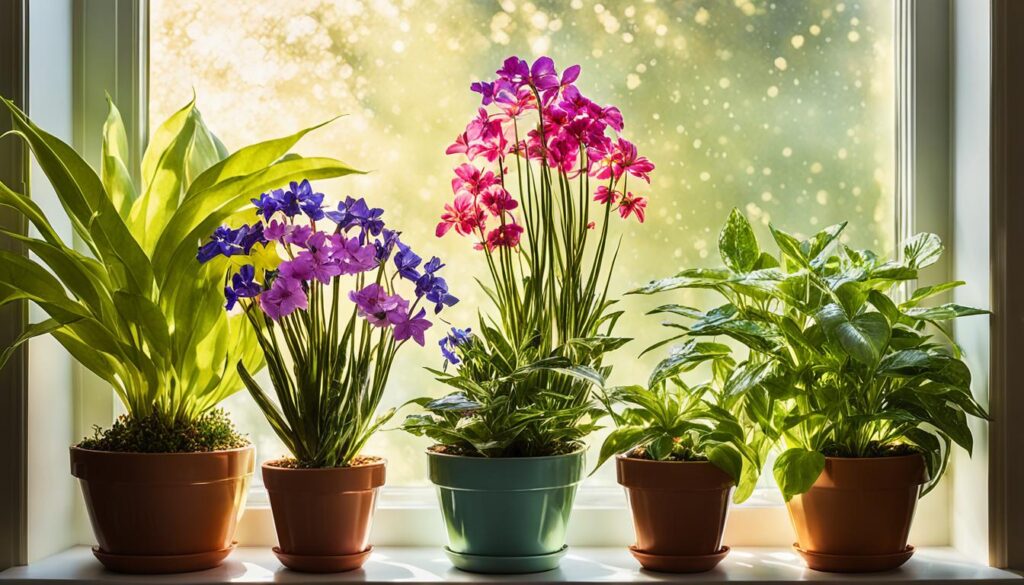
| Season | Growth Patterns | Watering Needs | Coloration | Flowering |
|---|---|---|---|---|
| Spring | New leaves and rapid growth | Increased watering | Green and vibrant | Some plants may bloom |
| Summer | Flowering | High watering needs | N/A | Flowering plants bloom |
| Autumn | Slower growth | Moderate watering | Fall foliage colors | N/A |
| Winter | Energy conservation | Reduced watering | N/A | N/A |
Winter Houseplant Care
In winter, sunlight levels decrease, and houseplants enter a period of dormancy. Adjusting care includes ensuring sufficient light exposure, reducing watering frequency, and avoiding fertilization. Low-light indoor plants, like Sansevieria, have lower water requirements during this season.
Ensuring Sufficient Light Exposure
During the winter months, natural light becomes scarce, which can negatively impact the growth of your houseplants. To maintain their health, it’s important to provide sufficient light exposure. Place your plants near a bright window that receives indirect sunlight, ensuring they receive at least a few hours of light each day.
Reducing Watering Frequency
In winter, houseplants go through a dormant phase where their growth slows down. As a result, they require less water. Overwatering can lead to root rot and other issues. To prevent this, reduce the frequency of watering. Before watering, check the moisture level of the soil by inserting your finger about an inch deep. Only water when the top inch of soil feels dry.
Avoiding Fertilization
Fertilizing your houseplants during winter is generally not recommended. The reduced light levels and slowed growth mean that plants have less need for nutrients. Applying fertilizers during this time can cause fertilizer burn and damage the delicate root systems. Instead, wait until the spring when the plants begin actively growing before resuming fertilization.
Low-Light Indoor Plants for Winter
Some houseplants are more tolerant of low light conditions, making them perfect choices for the winter months. Sansevieria, also known as Snake Plant or Mother-in-law’s Tongue, is a popular low-light indoor plant that can thrive in the limited sunlight of winter. Its sturdy leaves and ability to tolerate drought make it an ideal choice for busy households or those new to houseplant care.
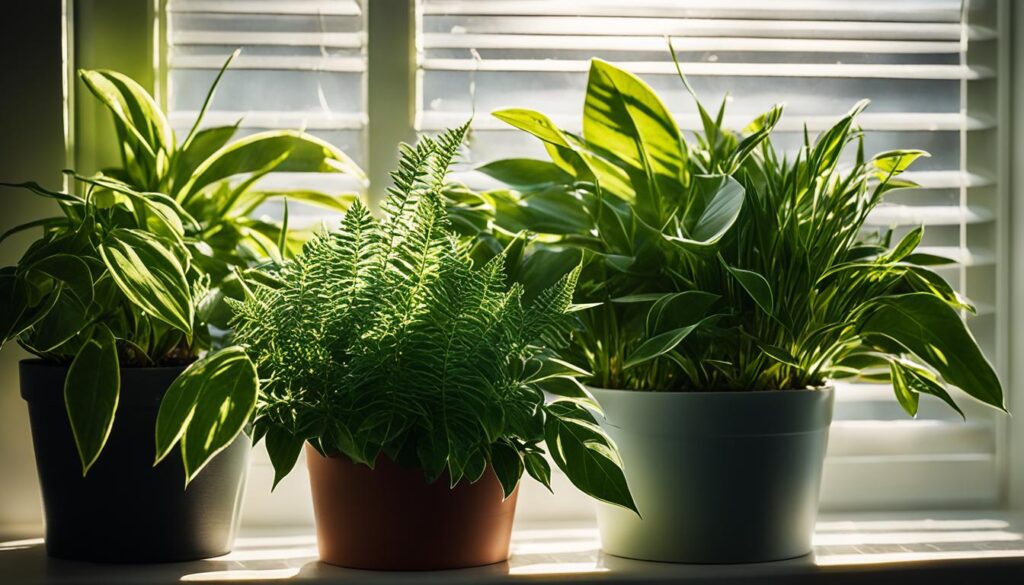
Image: Sansevieria is a low light indoor plant that thrives in winter conditions.
Spring Houseplant Care
As sunlight levels increase in spring, your houseplants awaken from their winter dormancy and begin to resume growth. This is an exciting time for both you and your plants, as you witness new leaves unfurling and vibrant colors emerging.
To ensure the health and vitality of your houseplants during the spring season, there are a few essential care steps to follow:
1. Move plants back to their original spot
During winter, you may have repositioned your plants to provide them with optimal light conditions. Now that the days are getting longer and brighter, gradually move your plants back to their original locations.
2. Increase watering frequency gradually
With the increasing light levels, your houseplants’ water requirements also change. Begin by gradually increasing the frequency of watering sessions. However, be cautious not to overwater your plants, as excess moisture can lead to root rot.
3. Start fertilizing
As your plants enter a period of active growth, they will benefit from regular fertilization. Choose a balanced, water-soluble fertilizer and apply it according to the instructions on the packaging. Fertilizing will provide your plants with the essential nutrients needed for healthy development.
4. Monitor soil moisture
During the spring season, it’s crucial to keep a close eye on the moisture levels in your plant’s soil. Check the soil regularly by inserting your finger about an inch deep. If the soil feels dry at this depth, it’s time to water your plants. Adjust the watering frequency accordingly based on your plant’s needs.
Pro Tip: Different plants have varying water requirements. Research specific care guidelines for your houseplants to determine the best watering schedule.
To summarize, with increasing light levels during the spring season, your houseplants need a little extra attention to thrive. Move them back to their original spots, gradually increase watering frequency, start fertilizing, and closely monitor soil moisture. By following these essential care steps, you’ll ensure your houseplants have a successful and vibrant spring season.
Summer Houseplant Care
During the summer season, houseplants benefit from the abundance of bright light levels, which promote rapid growth and lush foliage. To ensure the health and vitality of your indoor plants, it’s important to provide them with suitable light exposure, adjust watering frequency, and offer regular fertilization.
Ensuring Suitable Light Exposure
Position your houseplants in areas where they can receive adequate sunlight. However, be mindful that some plants may require protection from direct sunlight to avoid leaf scorch. To find the right balance, consider adjusting the placement of your plants or using sheer curtains to filter the intense sunlight.
Increasing Watering Frequency
Due to the higher light intensity and warmer temperatures during summer, houseplants tend to dry out more quickly. Therefore, it’s crucial to increase the watering frequency to prevent dehydration. Keep a close eye on the moisture levels in the soil and water your plants when the top inch feels dry.
Providing Regular Fertilizer Applications
With the rapid growth during summer, houseplants require an extra boost of nutrients to support their development. Fertilize your plants regularly according to the specific requirements of each species. Follow the instructions on the fertilizer packaging and avoid over-fertilization, as it can harm your plants.
| Summer Houseplant Care Tips: |
|---|
| 1. Ensure suitable light exposure for your houseplants, considering the need for protection against intense sunlight. |
| 2. Increase watering frequency to prevent dehydration due to higher light intensity and warmer temperatures. |
| 3. Provide regular fertilizer applications to support the rapid growth of your houseplants. |
Fall Houseplant Care
As temperatures start to drop and daylight hours decrease, it’s time to adjust your houseplant care routine for the fall season. With decreasing light levels, it’s important to provide the right conditions for your plants to thrive and prepare for the restful period ahead.
To maintain comfortable light levels for your houseplants, consider repositioning them to avoid extended sun exposure, especially during the late afternoon when the light intensity decreases. This will help prevent leaf scorching and ensure your plants receive the optimal amount of light.
As the light levels decrease, you may notice a decrease in your plants’ watering needs as well. It’s essential to adjust the watering frequency based on the soil moisture. Check the soil regularly and only water when it feels dry to the touch. Overwatering can lead to root rot, so it’s crucial to find the right balance.
Before the onset of winter, it’s a good idea to give your houseplants one final fertilizer treatment. This will provide them with the necessary nutrients to sustain them during the colder months. Use a balanced fertilizer, following the instructions on the label for the correct dosage.
Indoor humidity also plays a crucial role in the overall health of your houseplants during the fall season. As heaters are turned on to combat the cooler temperatures, the air indoors can become drier. Consider using a humidifier or placing a water-filled tray near your plants to increase the humidity levels.
By following these fall houseplant care tips, you can ensure that your indoor plants are well-prepared for the upcoming winter season. Providing the right light levels, adjusting watering frequency, fertilizing appropriately, and maintaining indoor humidity will help your plants thrive and stay healthy throughout the fall.
Houseplants’ Awareness of Seasonal Changes
Houseplants possess a remarkable ability to respond to the changing seasons, thanks to a biological phenomenon known as photoperiodism. Through this mechanism, plants can sense variations in light, temperature, air quality, humidity, and their overall environment, allowing them to adjust their growth and behavior accordingly.
Photoperiodism, influenced primarily by changes in daylight duration and intensity, plays a crucial role in the life cycle of plants. It helps them determine the appropriate timing for various growth stages, such as germination, flowering, and dormancy. By recognizing the shifts in environmental conditions, houseplants can synchronize their growth patterns with the natural rhythm of the seasons.
Photoperiodism is the plant’s internal clock, guiding its response to the changing seasons. It is the key that unlocks the door to understanding how indoor plants adapt throughout the year.
Light is the most critical factor influencing photoperiodism. As the seasons progress, the duration and quality of light change, signaling to plants the need to adjust their metabolic processes and development. For example, the longer daylight hours and increased intensity in spring prompt plants to produce new leaves and prepare for vigorous growth. In contrast, the shorter days and weaker sunlight in winter indicate the need for reduced metabolic activity and conservation of energy.
To visualize the impact of seasonal light changes on houseplants, the following table outlines the major light characteristics during each season:
| Season | Light Characteristics |
|---|---|
| Spring | Cool, balanced light; ideal for foliage growth |
| Summer | Intense, warm light; optimal for flowering |
| Autumn | Golden-hued light; triggers flowering in some plants |
| Winter | Subtle blue light; promotes slower growth and dormancy |
As you can see, the changing seasons bring unique light conditions that prompt houseplants to adjust their growth strategies accordingly. By understanding these responses, plant enthusiasts can provide the ideal care necessary to support their plants throughout the year.
Caring for Houseplants During Seasonal Changes
Coping with seasonal changes is key to maintaining the health and vitality of your indoor plants. As the seasons shift, it’s important to make adjustments to your plant care routine to ensure that your plants thrive. Here are some essential tips to help you care for your houseplants during seasonal changes:
Adjusting Watering Frequency
The moisture level in pots can fluctuate with changing seasons. During the warmer months when temperatures rise and light exposure increases, your plants may require more frequent watering to prevent the soil from drying out. Conversely, in cooler seasons when light levels and temperatures decrease, watering frequency should be reduced to avoid overwatering. Take into account the specific needs of each plant and monitor the moisture level in the soil to determine the appropriate watering schedule.
Fertilizing
Proper fertilization is essential for optimal plant growth and development. Different seasons call for different fertilizing practices. During the active growing seasons of spring and summer, it is recommended to fertilize your plants every two to four weeks to provide them with the necessary nutrients. In contrast, during the dormant periods of fall and winter, it’s best to reduce or stop fertilization, as plants require less energy during these seasons.
Repotting
Repotting your houseplants when needed is important for their overall health. As your plants grow, they may outgrow their current pots and need more space for their roots to expand. Repotting should be done during the active growing seasons when your plants can recover quickly from the transplant shock. Be sure to choose a pot with proper drainage and use a well-draining potting mix to ensure optimal root health.
Light Exposure
Light exposure plays a crucial role in your plant’s growth and development. Adjusting the placement of your plants based on the seasonal changes in light intensity and direction can help ensure they receive adequate light. As the seasons change, observe how the sunlight filters into your space and position your plants accordingly. This may involve moving them closer to windows during the darker winter months or providing some shade during the intense summer sun.
Indoor Humidity
Indoor humidity levels can vary with seasonal changes. In drier seasons, such as winter when indoor heating is often used, the air can become excessively dry, which can negatively impact your plants. Increase indoor humidity by using a humidifier, grouping plants together, misting them, or placing them on trays filled with water and pebbles. Monitoring and maintaining optimal indoor humidity levels will help promote healthy foliage and prevent issues such as leaf browning and dryness.
Caring for your houseplants during seasonal changes involves paying close attention to their specific needs and adapting your care routine accordingly. By adjusting watering frequency, fertilizing appropriately, repotting when necessary, ensuring proper light exposure, and maintaining indoor humidity levels, you can support the well-being and growth of your indoor plants throughout the year.
Conclusion
Adapting your indoor plant care routine to each season is crucial for the health and growth of your plants. By understanding the impact of light, water, and temperature variations, you can provide the best care possible. Here are some year-round plant care tips to ensure thriving foliage and a successful indoor garden.
During the winter, when sunlight levels decrease, make sure your houseplants receive sufficient light exposure and reduce watering frequency to avoid waterlogged roots. Low-light indoor plants like Sansevieria are ideal for this season.
In the spring, as sunlight levels increase, gradually increase watering frequency and resume fertilizing. Monitor soil moisture and adjust watering accordingly to prevent overwatering or underwatering.
In the summer, when light levels are at their brightest, provide appropriate light exposure and increase watering frequency. Regular fertilization is also important to support rapid growth. Protect certain plants from direct sunlight to prevent leaf scorch.
In the fall, as temperatures and light levels decrease, maintain comfortable lighting for your houseplants and adjust watering frequency based on soil moisture. Apply the final round of fertilizer before winter, repositioning plants to avoid extended sun exposure, and maintaining indoor humidity levels.
Remember, houseplants have an innate ability to sense the changing seasons and respond accordingly. By following these year-round plant care tips, you can create a nurturing environment that supports their growth, ensuring a beautiful indoor garden throughout the year.
For more valuable Expert Tips check out our comprehensive Houseplant Guide to Tips for Indoor Plant Care.
If you happen to be nearby, stop in at The Landscape Connection and say Hi. Michelle and I would love to meet you.
FAQ
How should I adjust my indoor plant care according to the changing seasons?
Adjusting your indoor plant care according to the changing seasons is essential for the growth and health of your plants. Understanding the impact of light, water, and temperature variations is key. This includes adapting watering frequency, fertilizing during the appropriate seasons, repositioning plants for optimal light exposure, and maintaining indoor humidity levels.
How does light influence plant growth?
The light spectrum consists of different colors, and blue and red light have the greatest influence on plant growth. Blue light affects phototropism, chlorophyll synthesis, stomatal regulation, and overall plant development.
How do seasonal light shifts affect houseplants?
Different seasons bring changes in the intensity and coloring of light. Spring light is cool and balanced, encouraging lush foliage growth. Summer light is intense and warm, ideal for flowering but may increase watering needs. Autumn light takes on a golden glow, triggering flowering in some plants. Winter light is characterized by subtle blue hues, resulting in slower growth and dormancy periods.
How do seasonal light changes impact houseplants?
Seasonal light changes affect the growth patterns of houseplants, with new leaves in spring, flowering in summer, and energy conservation in winter. Light intensity also affects watering needs and can influence the coloration of leaves. Some plants require specific light conditions to bloom.
How should I care for my houseplants during winter?
In winter, sunlight levels decrease, and houseplants enter a period of dormancy. Adjusting care includes ensuring sufficient light exposure, reducing watering frequency, and avoiding fertilization. Low-light indoor plants, like Sansevieria, have lower water requirements during this season.
What should I do to care for my houseplants during spring?
As sunlight levels increase in spring, houseplants wake up from dormancy and resume growth. It is important to adjust care by moving plants back to their original spot, gradually increasing watering frequency, and starting to fertilize. Monitoring soil moisture and adjusting watering accordingly is crucial during this season.
How can I care for my houseplants during summer?
Summer brings the brightest light levels, promoting rapid growth in houseplants. Care involves ensuring suitable light exposure, increasing watering frequency, and providing regular fertilizer applications. Some plants may require protection from direct sunlight to avoid leaf scorch.
What should I do to care for my houseplants during fall?
During fall, temperatures and light levels decrease, and houseplants prepare for a period of rest. Care includes maintaining comfortable light levels, adjusting watering frequency based on soil moisture, and applying the last fertilizer treatment before winter. Repositioning plants to avoid extended sun exposure and maintaining indoor humidity is also important.
How do houseplants sense the changing seasons?
Houseplants have an innate ability to sense the changing seasons through their response system known as photoperiodism. They can detect changes in light, temperature, air quality, humidity, and overall environment, which influence their growth and behavior.
How do I care for my houseplants during seasonal changes?
Caring for houseplants during seasonal changes involves adjusting watering frequency based on temperature and sunlight levels, fertilizing during the appropriate seasons, repotting when needed, repositioning plants for optimal light exposure, and maintaining indoor humidity levels.
Why is it important to adapt indoor plant care for each season?
Adapting your indoor plant care routine to each season is crucial for the health and growth of your plants. By understanding the impact of light, water, and temperature variations, you can provide the best care possible. Follow these year-round plant care tips to ensure thriving foliage and a successful indoor garden.


